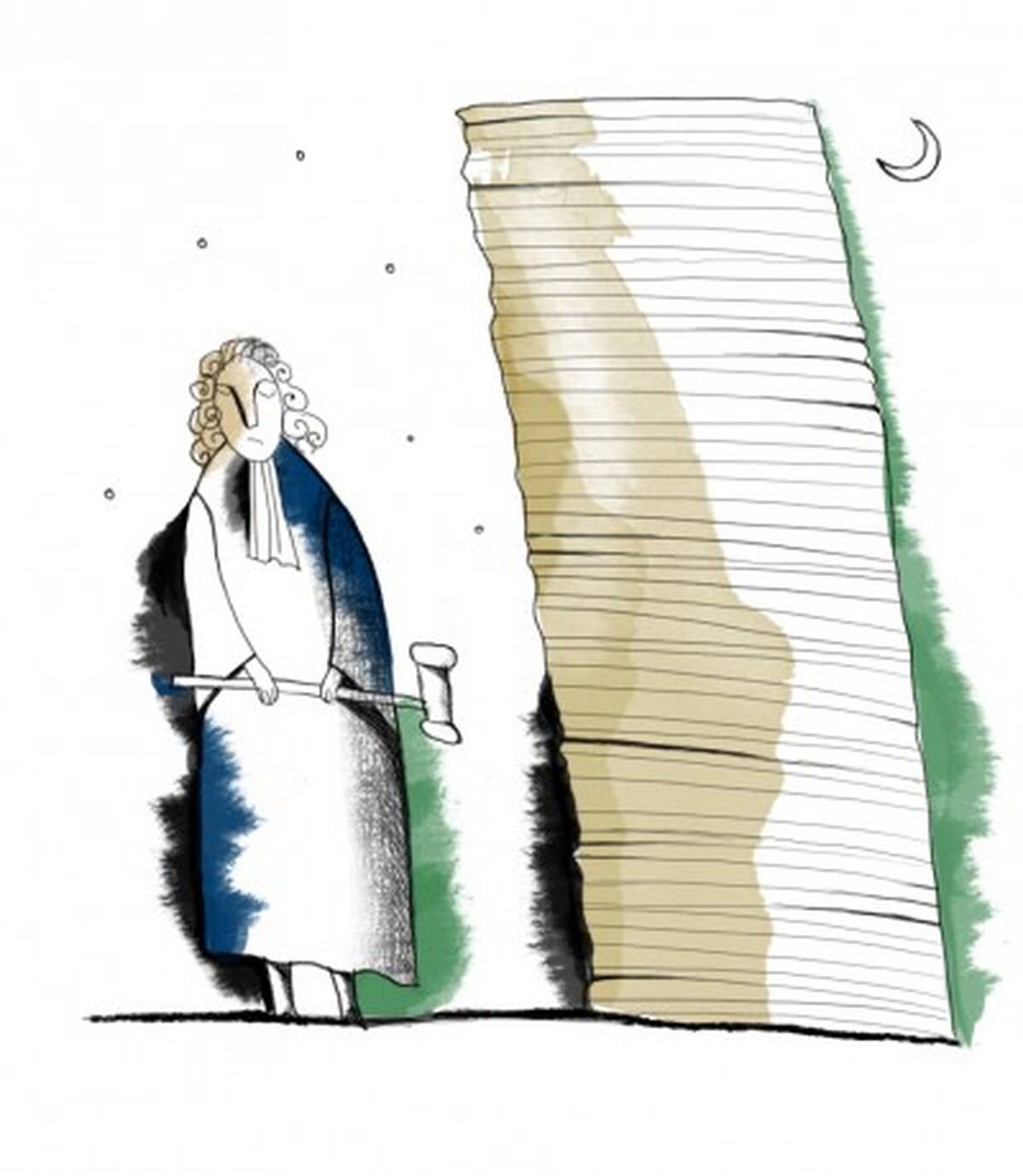Policy Finance & Accounting Apr 7, 2014
Red Ink, Red-Eyed Judges, and the High Costs of Crowded Bankruptcy Courts
The timing of a bankruptcy filing shapes the verdict and has consequences for all of us

In theory, court verdicts are based solely on the merits of the evidence in question. In reality, decisions are often handed down by tired and overworked judges who hear and rule on numerous cases each day.
For firms seeking to reorganize under Chapter 11 of the U.S. Bankruptcy Code, this means that some periods are better for filing than others. During economic downturns, for example, when bankruptcy judges have especially high caseloads, firms’ reorganization plans are approved at higher rates than when judges have lighter caseloads.
That can be good news for a firm hoping to reorganize during a recession, since having its plan approved means that it will stay in business and its debt load will be reduced. But there are trade-offs. Reorganization usually takes several months longer during a recession, meaning that a firm must either find financing or sell off assets to survive the delay.
The upshot is that it always pays to take context into account. Firms seeking to reorganize during a recession, for example, should consider taking proactive measures that might shorten their time in court, such as coming to a pretrial agreement with their debtors.
In addition to their implications for individual firms, crowded courts can have negative consequences for the broader economy. In a new study, Benjamin Iverson, an assistant professor of finance at the Kellogg School of Management, found that creditors pay the price when busy judges allow a higher rate of reorganization. As a result, banks are burdened with more bad debt—and reasons to scale back their lending—precisely when the economy most needs their participation.
“We have this bankruptcy system that’s just not flexible,” Iverson said. “It’s not ready to handle the stress exactly when companies are most in need of help.”
Path of Least Resistance
Ideally, bankruptcy courts smooth and improve the circulation of capital in an economy. They free up capital that is locked up in failing firms, making it available for investment elsewhere, or restructure viable companies that are burdened with unsustainable debt loads. How well they carry out this mission depends in part on the substance of the law itself. But Iverson’s research argues that extra-legal factors are vitally important to how well the system functions.
“We have this bankruptcy system that’s just not flexible,” Iverson said. “It’s not ready to handle the stress exactly when companies are most in need of help.”
Bankruptcy judges have three options when a Chapter 11 case comes before them: dismiss the case, liquidate the firm’s assets, or accept the restructuring plan proposed by the firm.
Iverson found that a rise in bankruptcy filings of 32 percent, which is the average during a recession, increases the probability that a firm’s reorganization plan will be approved—from 30 percent to about 38 percent. Iverson’s methodology allowed him to replicate the effects of an increase in caseload while ensuring that his results were not being caused by poor economic conditions. In other words, although bankruptcy filings tend to spike when recessions hit, he captured the effects of a spike in caseloads while filtering out the economic effects of the downturn.
While it increases the probability of approval for a reorganization plan, the 32 percent rise in bankruptcy filings lowers the probability that a firm’s assets will be liquidated or that the case will be dismissed. Large firms, which typically present more-complex cases and often have the legal means to lobby judges, are particularly successful in having their reorganization plans approved.
The precise reasons that busy judges approve reorganization plans at higher rates are unclear—probably even to judges, since subtle influences are at play. One factor is that rubber-stamping a plan to reorganize can be a way to put off a final decision. And for judges, at least, the stakes are low. If the plan fails, the firm will likely just end up back in court. If it succeeds, the judge’s decision will seem like a good one.
The Vicious Cycle
Meanwhile, dismissing a case or liquidating a firm’s assets can be time-consuming and stressful, particularly when the case is a close call. The judge has to determine a cause for her decision, which requires in-depth analysis of the likelihood that the firm will even be able to reach an agreement with its creditors, as well the firm’s long-term prospects under the proposed reorganization plan.
One sign that stress negatively affects judges’ decision making is the rate of “recidivism,” meaning the rate at which firms whose cases are dismissed by a judge return to bankruptcy court within three years of initially filing. For a median-sized firm in Iverson’s research, the three-year recidivism rate more than doubles during periods when judges are particularly stressed.
Whether a case is dismissed or a reorganization plan is approved, busy courts and stressed judges impose additional burdens on firms. Reorganization takes about six months longer during periods when courts are crowded, and high recidivism rates also lead to lengthy, drawn-out legal cases. Because of this, filing with a “prepackaged” bankruptcy plan—in which a debtor firm and its creditors settle on a reorganization plan prior to going to court—can help smooth out the process, reduce the court’s involvement, and lead to a more efficient reorganization when courts are busy.
When firms spend longer in court, they are not the only ones who pay. The additional costs tend to be passed on to the firms’ creditors, especially local banks. The costs are also borne by society at large, in the form of diminished economic activity. “Banks seem to suffer more-severe losses when bankruptcy judges are busier,” Iverson said. “So if lenders are getting hurt even more because the restructuring system isn’t efficient, that is going to exacerbate the cycle and make things worse.”
According to Iverson’s estimates, a 32 percent increase in bankruptcy caseloads translates into a 47 percent increase in loan write-offs by banks—from $5.3 billion to $7.4 billion in the period studied.
High Stress, Bad Choices
Iverson’s work adds to a steadily growing body of research on the influence of stress on people’s decision-making processes. His findings confirm the emerging consensus that stress has significant, negative effects—and under real-world conditions.
“A lot of the literature has relied on laboratory experiments,” Iverson said, “where they give people a small amount of time to make a decision or ask them to choose how much they’re going to invest, but put some other sort of stress on them. So I wanted to build off of that.
“This is an actual setting where we see time constraints varying dramatically depending on the judge and what the economic conditions are. And we can actually see some sort of real effect because there are time constraints.”
The workload and stress experienced by bankruptcy judges has risen dramatically over the past few decades. In 2010, the average bankruptcy judge handled more than three times the number of cases than the average judge in 1980. Adjusting these numbers to reflect the fact that there are different kinds of bankruptcies, which vary in the amount of time that they require, Iverson found that the average bankrupcty judge in 1980 had a total caseload of 503 hours, versus 1,141 hours in 2010.
Bankruptcy judges read, on average, more than 100 pages of legal briefs each day, and “eye fatigue and irritability set in well before page 50,” according to one judge quoted by Iverson. Another noted that bankruptcy courts can feel like an “emergency room for financially distressed consumer and commercial debtors.”
Despite the evidence that high stress levels lead to poor decision making, the number of permanent bankruptcy judgeships has remained constant for more than two decades. The Judicial Conference of the United States conducts a biannual study of judge caseloads, and it regularly pleads for new bankruptcy judgeships. Nonetheless, the U.S. Congress has not passed a bill approving the creation of new permanent positions since 1992.
Artwork by Yevgenia Nayberg.
Iverson, Benjamin. 2013. “Get in Line: Chapter 11 Restructuring in Crowded Bankruptcy Courts.” Working Paper.


